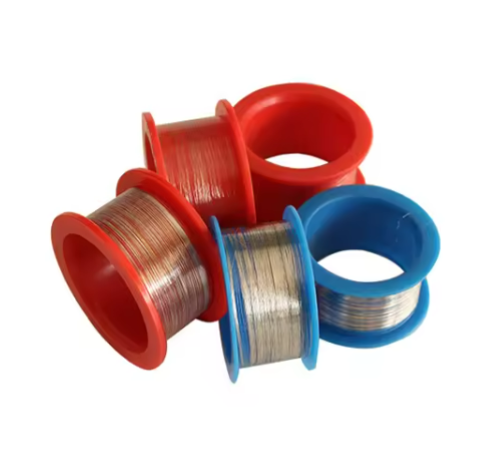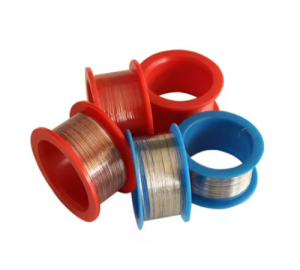
Platinum-iridium alloys, consisting of a combination of platinum and iridium, have become essential in various high-precision and high-durability applications. These alloys are celebrated for their exceptional durability, resistance to corrosion, and stability at high temperatures. This article will discuss the significance of platinum-iridium alloys, emphasizing their unique properties, specific applications, and specific cases in modern technology and industry.

Platinum-iridium alloys typically contain 90% platinum and 10% iridium, though the composition can vary depending on the application. The addition of iridium to platinum enhances several key properties:
| Application | Properties Utilized | Examples |
| Medical Devices | Biocompatibility, corrosion resistance, durability | Surgical instruments,
pacemaker electrodes |
| Electrical Contacts and Electrodes | Electrical conductivity, durability, high melting point | Spark plug electrodes,
laboratory electrodes |
| Scientific Equipment and Laboratory Tools | High-temperature stability, structural integrity | Thermocouples,
crucibles |
| Jewelry and Decorative Items | Luster, tarnish resistance, workability | Rings, bracelets,
necklaces |
| Aerospace Components | High melting point,
mechanical strength, corrosion resistance |
Turbine blades,
combustion chamber parts |
| Industrial Catalysts | Chemical stability,
catalytic properties |
Catalytic converters,
chemical production processes (fertilizers, petrochemicals, pharmaceuticals) |
This table provides an overview of the applications, properties utilized, and examples of platinum-iridium alloys, emphasizing their importance across various industries.
Related reading:
What Are The Special Applications Of Iridium Alloy?
Case Study: Pacemaker Electrodes
Platinum-iridium alloys are crucial in the medical field due to their biocompatibility and durability. Pacemaker electrodes, which must function reliably within the human body for many years, are often made from platinum-iridium. These electrodes ensure stable and long-lasting electrical connections, which are vital for the consistent operation of pacemakers. In a study published in the “Journal of Biomedical Materials Research,” pacemaker electrodes made from platinum-iridium exhibited significantly lower impedance and higher longevity compared to those made from other materials.
Case Study: Spark Plug Electrodes
In high-performance engines, spark plug electrodes made from platinum-iridium alloys provide exceptional durability and performance. The high melting point and resistance to erosion of the alloy ensure that the electrodes can withstand the extreme conditions within the combustion chamber. Tests conducted by automotive manufacturers have shown that platinum-iridium spark plugs can last up to 60,000 miles, significantly longer than conventional copper spark plugs, which typically need replacement after 20,000 miles.
Case Study: Thermocouples
Platinum-iridium thermocouples are used to measure high temperatures in industrial and scientific applications. Their stability at high temperatures ensures accurate readings over a wide range. In the steel manufacturing industry, where precise temperature control is crucial, platinum-iridium thermocouples provide reliable measurements, improving process control and product quality. Research by the National Institute of Standards and Technology (NIST) indicates that platinum-iridium thermocouples maintain accuracy within ±0.5°C over temperatures ranging from 0°C to 1,500°C.
Case Study: High-End Jewelry
The aesthetic and practical qualities of platinum-iridium alloys make them a popular choice in the jewelry industry. High-end jewelry items, such as rings and bracelets, benefit from the alloy’s luster and resistance to tarnish. The durability of platinum-iridium ensures that these pieces maintain their beauty and structural integrity over time, even with daily wear. According to the World Platinum Investment Council, platinum-iridium jewelry retains its value better than other precious metals, making it a preferred choice for investment-grade jewelry.
Case Study: Turbine Blades
The aerospace industry demands materials that can withstand extreme conditions. Platinum-iridium alloys are used in high-performance engine components, such as turbine blades. These components operate under high stress and temperature, and the alloy’s high melting point and mechanical strength ensure their reliability. In testing by NASA, platinum-iridium turbine blades demonstrated superior performance and longevity compared to those made from traditional nickel-based superalloys, contributing to improved engine efficiency and safety.
Case Study: Catalytic Converters
Platinum-iridium alloys are employed as industrial catalysts, leveraging their chemical stability and catalytic properties. In catalytic converters, which reduce harmful emissions from vehicles, platinum-iridium catalysts facilitate the conversion of pollutants into less harmful substances. Studies by the Environmental Protection Agency (EPA) have shown that catalytic converters with platinum-iridium catalysts achieve higher conversion efficiencies and longer lifespans compared to those using pure platinum, significantly reducing vehicle emissions.
The significance of platinum-iridium alloys lies in their unique combination of properties and high-precision and high-durability applications. The case studies highlighted in this article underscore the impact of platinum-iridium alloys on modern technology and industry, demonstrating their vital role in advancing various fields and improving the quality and reliability of numerous products and processes.
As technology continues to evolve, the demand for these versatile and reliable alloys is likely to grow, further solidifying their importance in modern industry and technology. For more information, please check Advanced Refractory Metals (ARM).
Copyright © 1994-2024 Advanced Refractory Metals owned by Oceania International LLC, All Rights Reserved.